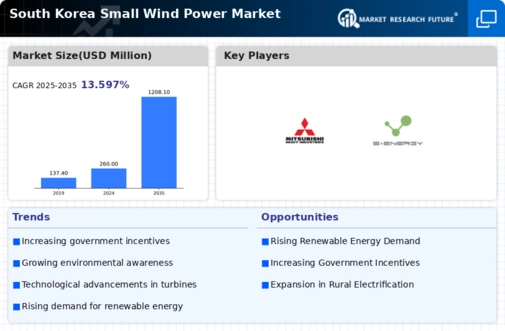Rising Energy Costs
In South Korea, the increasing costs of conventional energy sources are driving interest in the small wind-power market. As fossil fuel prices fluctuate, consumers and businesses are seeking alternative energy solutions to mitigate expenses. The small wind-power market offers a viable option, with the potential to reduce energy bills by approximately 30% over time. This economic incentive is particularly appealing in rural areas where energy costs can be disproportionately high. As energy prices continue to rise, the small wind-power market is likely to gain traction, as more individuals and organizations recognize the long-term savings associated with wind energy.
Technological Integration
The integration of advanced technologies is significantly influencing the small wind-power market in South Korea. Innovations in turbine design, such as vertical-axis wind turbines, are making small wind systems more efficient and suitable for urban environments. Additionally, the incorporation of smart grid technology allows for better energy management and distribution, enhancing the overall effectiveness of small wind installations. As these technologies become more accessible, the small wind-power market is expected to expand, attracting a broader range of consumers who may have previously considered wind energy impractical. This trend indicates a shift towards more sustainable energy solutions.
Decentralized Energy Production
The trend towards decentralized energy production is reshaping the small wind-power market in South Korea. As communities and individuals seek greater energy independence, small wind systems provide an attractive solution. This shift is particularly relevant in remote areas where traditional energy infrastructure may be lacking. By harnessing local wind resources, consumers can generate their own electricity, reducing reliance on centralized power grids. This movement towards self-sufficiency is expected to drive growth in the small wind-power market, as more people recognize the benefits of localized energy solutions.
Regulatory Framework Enhancements
The small wind-power market in South Korea is experiencing a boost due to the evolving regulatory framework. The government has been actively revising policies to facilitate the installation and operation of small wind turbines. Recent amendments to the Renewable Energy Act aim to simplify the permitting process, which could potentially reduce installation costs by up to 15%. Furthermore, the introduction of feed-in tariffs guarantees a fixed price for energy produced, enhancing the financial viability of small wind projects. This regulatory support is crucial for attracting investments and fostering innovation within the small wind-power market, as it provides a stable environment for stakeholders to operate and expand their businesses.
Environmental Sustainability Initiatives
Growing awareness of environmental issues is propelling the small wind-power market in South Korea. The government and various organizations are promoting sustainability initiatives aimed at reducing carbon emissions and reliance on fossil fuels. The small wind-power market aligns with these goals, offering a clean energy alternative that contributes to national targets for renewable energy generation. As public sentiment increasingly favors sustainable practices, the demand for small wind systems is likely to rise. This shift not only supports environmental objectives but also encourages local economies to invest in renewable technologies, further bolstering the small wind-power market.













Leave a Comment